Summarize this blog post with:
In a nutshell: Tracking the right Google ad metrics is crucial for optimizing your Google ad campaigns. While CTR and Quality Score indicate the ad relevance and engagement, conversion rate and CPC provide insights about how well your ads drive users into the desired action and the cost of managing them. Besides monitoring metrics, you must also optimize your Google ad performance by organizing the ad groups, reviewing auction insights, experimenting with different campaign types and presenting data in actionable dashboards. This detailed framework will help you tailor informed business decisions, enhance Google campaign performance and maximize ROI.
Google Ads offers comprehensive features to tailor your online advertising strategy. However, this also means dealing with a lot of campaign data that can clutter your spreadsheets. Determining which key Google ad metric to focus on can be challenging.
From impressions and clicks to conversions, there’s a lot to go through. Besides, you must ensure your Google campaigns run seamlessly without exceeding your client’s ad budget.
So, how do you determine the right Google Ads metrics to track? Which ones are truly worth measuring? How to track and optimize client ROI?
Don’t worry; we’ve got you covered.
In this article, we’ll explore the top 16 Google Ads metrics you must monitor, along with free, customizable templates to get started. We’ll also provide six proven tips to improve your Google Ads performance, and show you how to leverage a dedicated Google Ads reporting tool to streamline and automate your campaign tracking in one place.
Ready to dive in? Let’s get started.
What are Google Ads Metrics?
Google Ad metrics give you insights into how your campaigns are performing and the next steps that have to be taken. They inform key changes and optimizations for improving your campaign performance to achieve better results.
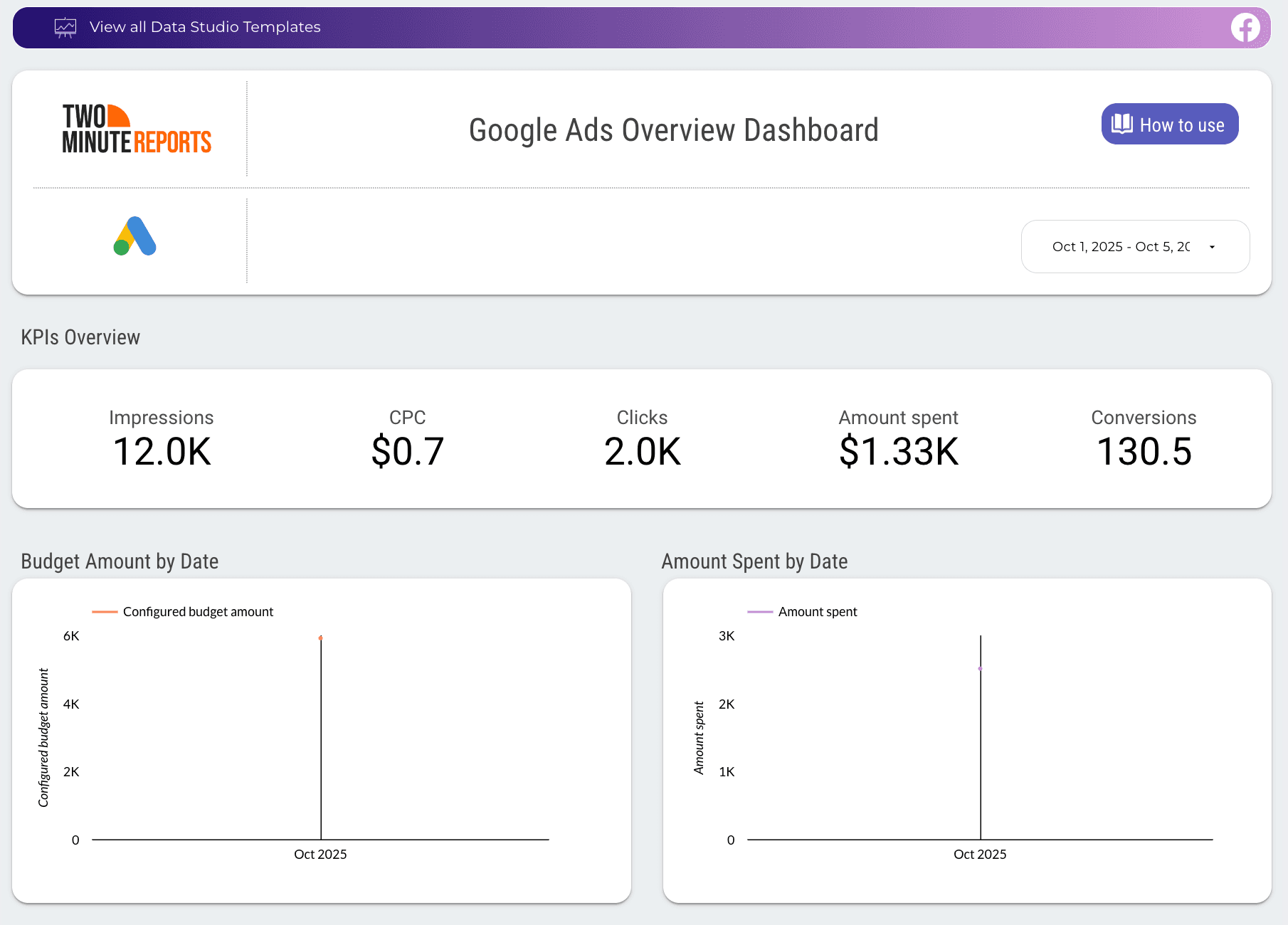
While there are many Google Ad metrics to track, understanding what impact each metric delivers is crucial to crafting a winning campaign strategy. The following questions will help you understand how each query is tied to a Google ad metric so you can easily map key findings and measure insights.
- Are my ads reaching the right audience?
- How effective are my Google ads at driving traffic?
- How much am I spending on my ads, and is it within the budget?
- What is my return on investment or ROAS?
- How efficient is my ad spent in converting users?
- Which devices or platforms are bringing in the highest traffic?
The answers to such questions are crucial for optimizing your client’s Google Ad performance. You can steer your client’s campaign to success by relying on evidence rather than assumptions.
| Pro Tip: If you’re just getting started, keep it simple. Start with the basics and identify which metrics reflect your Google ad campaign. As you get comfortable, expand your analytical horizon. |
Now that you’ve got an idea, in the next section, we’ll be discussing the top 16 Google ad metrics that you must focus on while analyzing your client’s Google ad campaigns. These fundamental metrics provide a solid baseline to make informed business decisions.
16 Most Important Google Ad Metrics To Track
In this section, we’ll explore the core Google ad metrics every digital marketer should track to measure the success of the client’s Google ad campaigns.
Want a summary of all Google ad metrics? Skip to the table below
1. Click-through rate
What it is: How many users have seen and clicked on your ad? You can calculate the CTR of your ad campaign by dividing the number of clicks by the number of impressions. The average click-through rate in Google Ads is 6.66%.
CTR = (Clicks/Impressions) * 100
Why it matters: A high CTR indicates the relevance of your ad to user intent, while a low CTR suggests you should revisit your ad campaign strategy. You must determine which ad elements (ad copy, targeting, design, or placement) contribute to the least clicks and refine them accordingly.
However, when you correlate CTR with relatable metrics like conversions, the real potential of the CTR metric is unveiled. If your ad garners many clicks but results in few conversions, it is engaging but fails to connect with users in the subsequent stages of their journey.
How to improve:
- Infuse emotional elements into your ad copy to make it persuasive.
- Target only relevant keywords that align with your campaign; otherwise, you’ll gather impressions without clicks.
- Regularly perform A/B testing to refine and identify the winning ad variant to improve CTR.
| Pro Tip: Your ad copy should resonate with the user’s emotions. For example, the ad copy “Create actionable dashboards 80% faster” is much better than “Create visual dashboards that do the heavy lifting for you” as the copy states an impactful outcome. |
2. CPC - Cost Per Click
What it is: The amount spent when a user clicks on your ad. It is an important metric to track because it determines your campaign’s overall ROI (return on investment). The average Google Ads cost per click is $5.26.
CPC - [Total cost /Total number of clicks]
Why it matters: Understanding CPC is the foundation for a successful Google Ad campaign. A high CPC hints that you're burning your client’s budget quickly. This might be due to increased online competition, changes in ad quality scores, or targeting irrelevant keywords. Plan and predict your advertising outcome based on the ad spend efficiency.
How to improve:
- Focus on highly targeted ad groups that satisfy one intent at a time
- Craft landing pages with a compelling offer.
- Schedule your ads to display when your prospects are most active online.
- Optimize bid adjustments based on device and location targeting to get better value for the money spent.
| Pro Tip: It's okay if you don’t have enough budget for expensive keywords. But remember to consider keyword volume and intent. You can have a healthy mix of low-cost and high-converting keywords to decrease your ad’s CPC. |
3. Conversions
What it is: Refers to the number of users who complete the goal after clicking on your ad. Tracking conversions helps you measure your campaign’s effectiveness in turning visitors into customers.
You can set up conversion tracking to analyze purchases, signups, and phone calls from your ads, as well as app installs and in-app actions.
Why it matters: Conversions are the cornerstone of your Google ad campaigns. They signify whether your target audience fulfills your goal. You can understand how well your ads perform, calculate ROI to know profits, understand audience insights and interactive touchpoints, and identify intent-driven keywords that bring traffic to your campaign.
How to improve:
- Use clear call-to-actions to navigate users to the right destination.
- Utilize ad extensions, such as site links, callouts, etc., to provide additional context and enhance visibility.
- Apply smart bidding strategies like target ROAS or target CPA to optimize conversions based on your goals.
- Regularly analyze and adjust budgets based on the campaign performance data.
4. Conversion Rate
What it is: Refers to the percentage of users who take that desired action. Examples include form signups, purchasing, subscribing to a newsletter, downloading an ebook, etc. The goal varies depending on your client’s advertising objective.
Conversion Rate = (Conversions/Total number of ad interactions) * 100
If you had 20 conversions from 1000 interactions, your conversion rate would be 2%.
Why it matters: Conversion rate is a key Google Ad metric that determines the success of your campaign. The higher the conversion rate, the more engaging your ads are. Knowing your conversion rates lets you create tailored marketing campaigns for various digital channels. The Google Ads average conversion rate in 2025 is 7.52%.
How to improve:
- Minimize the user journey by including only key progressive stages.
- Test and refine landing pages for high speed and accuracy to avoid friction points.
- Personalize landing pages based on the keywords that users input in search.
- Optimize your ad for every user touchpoint.
| Pro Tip: Set up a conversion tracking module. Once you set up your module, you can see how your changes affect your Google ads conversion rate. This module is also helpful for analyzing the conversion results of past ad campaigns. |
5. Cost
What it is: Refers to the amount you’ve spent running your Google ad campaigns over a specific time period.
Why it matters: You manage your client’s Google ad budget as an agency. You must decide how and where to invest to make campaigns profitable, which is your core priority.
How to improve: Costs relate to managing CTR, clicks per cost, acquisition, and even cost per thousand impressions [awareness campaigns]. Brainstorm and figure out how to optimize these different costs without compromising your client’s budget.
| Pro Tip: If past ad spend data is available, you can compare the trends and identify the spending timeline. Then, you can derive critical insights and optimize for better outcomes. |
6. Impression Share
What it is: Refers to the percentage of impressions your ads receive compared to the total number of impressions your ads could get.
Impression Share = (Impressions Received/Total eligible impressions) * 100
Eligible impressions are calculated using multiple factors like targeting settings, ad quality, and approval.
Why it matters: Google Ads Impressions share signals whether your ads reach the intended audience. The higher the impression is shared, the more your ad reaches the desired audience. If the numbers are too low, go back and revise your ad targeting.
How to improve: Increase the campaign’s targeting and bidding to improve the overall visibility. Enhance the ad quality by using intent-driven keywords to reach the right audience.
7. Cost Per Mille
What it is: Refers to the cost per 1,000 impressions. Advertisers pay a set amount for every thousand times their Google ad is shown, regardless of whether users click it.
CPM = (Amount Spent/Total impressions) x 1000
Why it matters: With CPM, advertisers can predict and control the cost of brand awareness campaigns. A lower CPM means you achieve high visibility with minimal costs, whereas a high CPM indicates substandard targeting, high competition, or poor ad relevance. Overall, understanding and managing CPM is vital for improving your Google ads’ visibility and impact.
How to improve:
- Analyze which placements have the highest audience engagement and target them for increased exposure.
- Create ads that closely match the interests and needs of your target audience.
- Use demographic, geographic, and interest-based targeting to stay on your target audience’s radar.
- Regularly test different ad copy, images, and formats to determine what resonates the best.
8. ROAS
What it is: Return on Ad Spend (ROAS) refers to the revenue generated based on the amount spent on the campaigns. It is a key Google ad metric indicating whether your ads deliver the expected profits.
ROAS = (Revenue generated from ads/Cost (total ad spend))
Why it matters: If your client asks, “How are ad campaigns performing?” ROAS will be your go-to metric. A high ROAS signals a positive return, generating maximum efficiency. With ROAS, you can understand how your campaign’s marketing efforts translate into revenue. If they don’t, it’s time to reassess your Google campaign strategy.
How to improve:
- Avoid setting unrealistic ROAS targets.
- Segment audiences to target based on their interests, demographics, and purchasing behavior.
- Experiment with different ad variations by testing new ads alongside existing ones.
- Leverage exact match keywords for precise targeting.
- Don’t unquestioningly optimize your ROAS based on monthly seasonality trends. Ensure it aligns clearly with your client’s objectives.
| Pro Tip: Evaluate your Google campaign’s performance regularly every 2-4 weeks. Doing so will give you insights into making timely adjustments based on market changes, enabling you to optimize performance and spending. |
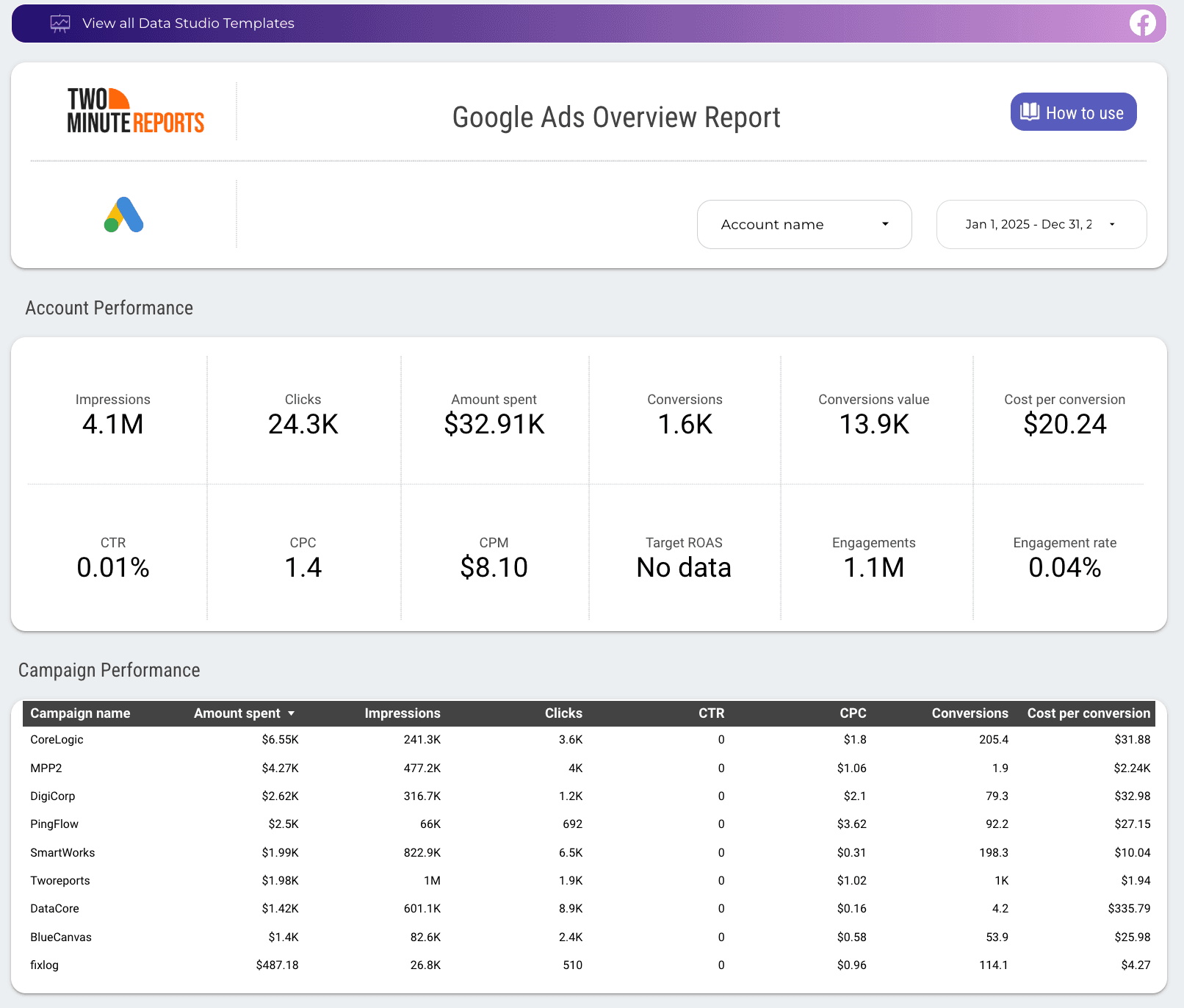
Get detailed performance insights across accounts, campaigns, and ads with our free Google Ads template. Compare cost, conversions, and visualize clicks by device and country. Optimize your strategy and drive measurable outcomes.
9. Quality Score
What it is: Quality Score is Google's evaluation of how good your ad is. The score ranges from 1 to 10 and assesses your ad quality. It helps you diagnose crucial ad elements to bolster campaign effectiveness.
The following three elements impact the Quality Score:
- Landing page experience
- Expected Click-through rate
- Ad relevance
Each component above will be evaluated as "Average," " above average," and "below average." This evaluation is based on the comparison with the advertisers whose ads display for the exact keyword over the last 90 days.
Why it matters: Your quality score reflects how well your ad aligns with the overall intent and the user experience. A high-quality score leads to lower costs and better return on investment. Achieving a perfect score is quite challenging, but if you rank consistently between 7 and 10, you signal Google that you’re a perfect fit.
How to improve:
- Review your landing pages to ensure they offer what people seek.
- Increase the loading speed of landing pages across mobile and desktop.
- Test different call-to-action triggers to match your landing page intent.
- Regularly perform keyword research to refine your ad groups.
- Deliver consistent messaging from the ad to the landing page.
Note: Google evaluates a keyword’s quality score based on how closely it matches the search query. Changing the keyword’s match type (e.g., broad match to phrase match) does not alter the quality score for that keyword. The quality score depends on the landing page experience, relevance, and CTR, not the specific keyword match type.
10. Ad Rank
What it is: The position of your ad on Google SERP. The example below shows two sponsored results for “house cleaning services.” The first ad is referred to as having the “absolute top” ad rank, as it captures the premium position in Google search.

Ad Rank is calculated based on your bids, ad quality, search query, impact of ad assets [headlines, descriptions, extensions], landing page, etc. All these factors must align to secure the highest spot.
Ad Rank = Bid x Quality Score
Why it matters: Ad rank determines your ad visibility. This rank is crucial because the top-ranking ads are the only ones your customers see, leading to higher conversion rates. If your ads need to be on top of Google's real estate, improve their quality and relevance.
How to improve:
- Craft hyper-relevant landing pages to boost engagement.
- Incorporate ad extensions like site links or phone numbers to gain more engagement.
- Prioritize customer intent by tapping on their needs and pain points.
- Avoid using clickbait for the sake of getting clicks.
- Filter out negative keywords to block your ad from appearing in irrelevant searches.
- Test the best bidding options to know which works well for your campaign.
| Pro Tip: If your ad rank is low, troubleshoot landing pages, ad copy, bidding, and other supporting elements individually. This will help you understand what’s working and what’s not. |
Note: Google recalculates your ad rank for every auction, which means your ad’s position may vary.
11. Cost Per Acquisition
What it is: CPA refers to the cost you spend on acquiring one customer or lead via your Google ad campaign. You’ll find this Google ad metric associated with each level, campaign, ad group, and keyword of your Google ad campaign.
CPA = Total cost/conversions
Why it matters: Tracking CPA tells you if you spend too much of your client’s budget on convincing a new customer. For example, if you spend $400 on a campaign and achieve 50 conversions, your CPA is $8.
A lower CPA means paying less for each conversion, resulting in high profitability. While a high CPA could scour your client’s investment, it also means generating less profits due to campaign ineffectiveness.
Therefore, monitor CPA regularly to maximize your ad budgeting and spending efficiency.
How to improve:
- When you first set up your target CPA or make changes, allow for a 1-2 weeks learning period to help Google’s algorithm understand patterns and serve you with better results.
- Other than keywords, optimize bids for device, demographics, audiences, and interaction types (e.g., phone call extensions)
- Use available ad text slots to align with different combinations of user search queries.
- Regularly monitor your campaign performance and tweak target CPA based on the results or business goals.
| Pro Tip: Target CPA works well only when you properly set up conversion tracking. Verify whether Google ads correctly register your conversion tags. |
12. View Through Conversions (VTC)
What it is: Measures how many users saw your ad, didn’t click initially, but later converted. Through VTC, you can understand how your Google ads indirectly influence your audience’s purchasing decision.
To calculate VTC, Google compares the number of times the ad is shown with the number of conversions within a specific period (30 days).
Why it matters: VTC gives you a better understanding of how users interact as they take longer to convert. It accurately represents your Google ad campaigns' reach and effectiveness, garnering brand exposure and customer loyalty insights.
However, there’s a hidden caveat here. Your ads will not influence your audience with just one view, which could entirely change your perspective. So, analyzing VTC with other supporting metrics is better for gauging meaningful insights.
How to improve:
- Limit your ad frequency so your audience won’t get bored or frustrated - avoid ad fatigue.
- Optimize for better ad placements to increase online visibility.
- Retarget users who have previously clicked your ad with follow-up ads to drive them back to your website or landing pages.
- Enhance your ad copy for different ad creatives types like image, video, etc.
13. Cost per Install
What it is: The amount you pay for each app installation. It is the cost of acquiring a new app user through your campaign.
CPI = Total Ad Spent/Total number of installs
If your app advertising spend is $5000 and you acquire 2500 installs, your CPI will be $2, i.e., you’ve spent $2 for every app install.
Why it matters: CPI indicates whether your app campaign strategy is effective in convincing the users to install the app. A lower CPI signals increased app downloads, driving business growth, whereas a high CPI informs you to further optimize your app strategy and targeting. Many factors influence CPI, such as device platform (iOS or Android), country, app category, advertising network, user intent., etc.
Since CPI incurs high advertising costs, plan and target the right audience at the right time. Monitoring CPI consistently lets you set benchmarks and understand the industry standards, enabling you to make strategic adjustments to maximize app downloads.
How to improve:
- Adjust your bidding strategies by identifying trends from previous campaigns to optimize your ad spending and ROI.
- CPI changes by country. So, identify the best geographical location that offers better conversions and lower cost per install.
- Refine your ad creatives and copy to persuade users to take action.
- Allocate budgets by analyzing the engagement and performance of iOS and Android platforms.
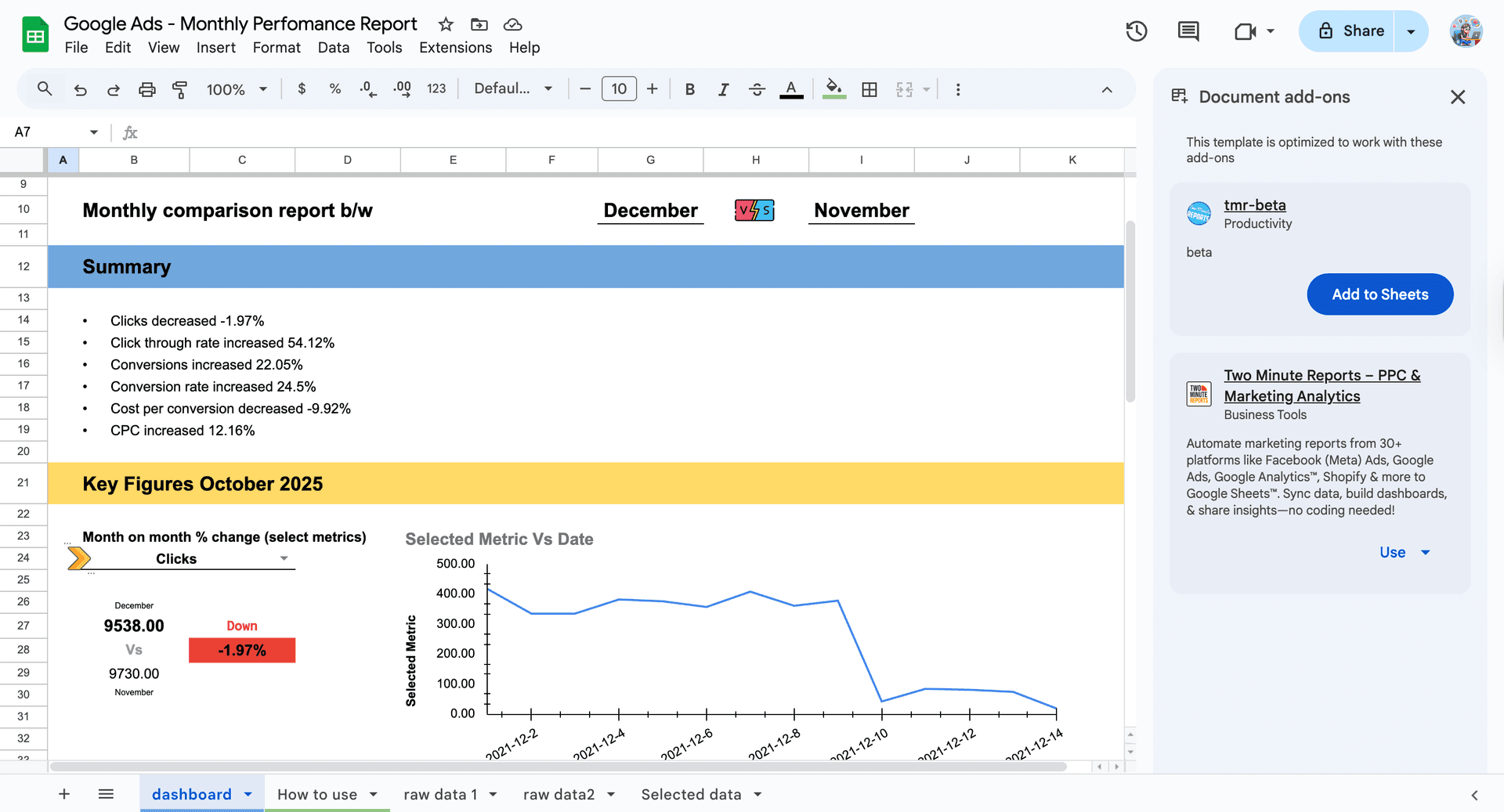
Use our Google Ads template to track your monthly campaign performance. Track the top 10 keywords, number of clicks and conversions across different devices. Visualize a detailed overview of key metrics for the last three months.
14. Clicks by Campaign
What it is: Refers to the total number of clicks your Google ads receive for each campaign. It tells you how many visitors clicked on your ad and landed on your website.
For example, if Campaign A receives 50 clicks, Campaign B receives 100 clicks, and Campaign C receives 75 clicks, it’s evident that Campaign B receives the highest clicks and drives more users to the destination site.
Why it matters: Clicks by Campaign is an important Google ad metric as it evaluates each campaign's performance in driving traffic. You can understand which campaigns get the most clicks, identify the factors contributing to the highest/lowest clicks, and fix and optimize them to improve engagement and minimize ad spending.
How to improve:
- Insert relevant keywords such that they focus on customer intent and drive them to take action.
- Create hyper-relevant copy that aligns with your campaign goal and messaging intent.
- Understand the growing pattern where you notice campaigns with the highest clicks, gather those insights, and make necessary adjustments.
15. Cost Per Conversion
What it is: The average cost for each desired conversion, such as signing up for a free trial, filling out a form, taking the website action, installing the app, etc.
CPC = Total Cost of Ads/Number of conversions
If you spend $1500 for your ad campaign and achieve 500 conversions, your CPC will be $3.
Why it matters: Knowing how much it costs to acquire one customer tells a lot about your campaign strategy. If the cost per conversion is too high, you need to fix the frictional points. At the same time, a lower CPC indicates that your ad is well-optimized for convincing customers to take action.
How to improve:
- Re-examine your existing copy and make relevant changes to make it captivating.
- Analyze when your target audiences are most active and run ads.
- Optimize the page layout for mobile devices.
- Have a minimalistic appeal by removing distractional elements.
- Inform your audience on what they should do next.
16. Cost Per View
What it is: Cost-per-view is the bidding strategy for video campaigns where you pay for a view. A view is counted when a visitor watches 30 seconds of your video ad or its duration (if it’s shorter than 30 seconds) or interacts with the ad. Typical video interactions include CTA overlays, cards, and companion banners.
CPV = Total ad cost/Number of views
If you’ve spent $3000 on your video ad and have 9000 views in total, the ideal CPV would be 0.33.
Why it matters: With static text or image posts, visitors might see your ad, interact with it, and click the link to reach the destination site. This is not possible for video ads. By tracking CPV, you can evaluate how engaged viewers are with your video content, how long they watch, and when they drop off.
CPV helps you refine budget plans by analyzing which video campaigns resonate the most with your target audience. Every penny you spend should be valuable in capturing a visitor’s attention.
How to improve:
- Run high-quality video ads to hook your audience’s interest till the end.
- Track CPV alongside metrics like CPM and CPI to get a better understanding.
- Expand your targeting options so that the ad-serving system will identify areas where your bids can be more competitive, reducing the cost.
[Table] Top 16 Google Ad Metrics
A summarized version of the top 16 Google ad metrics discussed above gives you on-spot insights.
| Google Ad Metric | Definition | Usage |
| 1. CTR | Number of users who have clicked your ad. | Gauge the effectiveness of your ad copy and landing page to garner clicks. |
| 2. Cost Per Click | The amount you spend when a user clicks on your ad. | Optimize bids to manage your client’s budget. Target hyper-relevant keywords to lessen CPC costs. |
| 3. Conversion Rate | The percentage of users who satisfy the purpose of pursuing the desired action. | Tells whether your Google ads are engaging enough to drive potential search traffic. |
| 4. Cost | The total amount you’ve spent on your client’s Google ad campaign | Ensure that the cost aligns with your client’s ad budget to improve spending efficiency. |
| 5. Impression Share | The percentage of impressions your ads receive compared to the total impressions your ads could get. | Highlights missed opportunities. If the impressions are less than 100%, your ad could have reached more people but was blocked due to inefficiencies. |
| 6. ROAS | How much profit have you generated compared to the investment you’ve made? | High ROAS signals better revenue. However, incremental adjustments should be made to set realistic targets. |
| 7. Quality Score | Google’s rating from 1-10 to measure your ad quality. | A high QS indicates that your ads serve the right intent. Ensure consistent ranking to avoid disappearing from search. |
| 8. Ad Rank | Your ad position in Google. | The higher the rank, greater the visibility. |
| 9. Cost Per Acquisition | How much did it cost to acquire one potential customer or lead? | The lower the CPA, the better the ad spent. |
| 10. View Through Conversions | Measures how many users viewed your ad, did not take action, but later converted. | Analyzes the effectiveness of your Google ads over a long period. |
| 11. Conversions | Refers to the number of users who complete the goal after clicking on your ad. | Measures your ad campaign’s effectiveness in persuading users to take the intended action. |
| 12. Cost Per Mille | Cost per 1000 impressions. | The lower the CPM, the more effective your ad is in reaching the potential target audience. |
| 13. Cost Per Install | The amount you pay for each app installation. | Minimizing CPI ensures you target the right audience for promoting your app campaign. |
| 14. Clicks by Campaign | The total clicks received for each Google ad campaign. | Break down each campaign and analyze the factors contributing to the highest clicks. |
| 15. Cost Per Conversion | The cost associated with each conversion action. | While a lower CPC indicates minimized ad spending, a higher CPC signals you to revisit your campaign strategy. |
| 16. Cost Per View | The amount you are willing to pay for each video ad view. | With CPV, you tell Google you’re willing to spend a maximum amount for each view. |
6 Proven Tips to Optimize Google Ads Performance
Now that you’ve got an idea of what key Google ad metrics to track, our next focus will be on delving into 6 proven tips to optimize your client’s Google ads performance.
1. Basics come first
The #1 mistake marketers make is that they immediately jump into campaign ideation - ad copy, targeting, etc. Starting with an end goal is fine, but that doesn’t mean you can skip the fundamentals.
So, let’s start with the basics - organize your ad groups. The better you structure them, the more you can effectively manage your Google ads for simplified performance tracking.
 Image Source: Google Ads Help
Image Source: Google Ads Help
As a marketer, you know the struggle of managing and running multiple Google ad campaigns. When you organize them, you build momentum, amplify messaging, and allocate the best resources, adding value to your client’s crucial investment.
| Pro Tip : Within each ad group, target the keywords that are most relevant to that ad group. |
2. Transform Google Ads KPIs into interactive dashboards
Your Google Ads dashboard might sound Latin and Greek with excessive data. To create effective client marketing reports, you need comprehensive campaign insights that tell you what has worked and what has not. Moreover, the customization options are pretty low inside the native Google ad platform.
To overcome this and streamline ad reporting, you can use Two Minute Reports’ Google Ads reporting tool. Here’s how it makes your campaign tracking efficient:
- Connect your ad accounts in Google Sheets or Looker Studio.
- Extract relevant Google Ads metrics across multiple client accounts
- Visualize performance trends across accounts, campaigns, ad groups and ads.
- Share branded reports as PDFs with your clients and stakeholders.
Adapting this straightforward approach ensures that you’ll focus on optimizing the Google ad campaign strategy by delivering accurate, data-driven reports to your clients.
3. Experiment with different Google campaign types
Start small and scale big with different Google ad campaign types.
You uncover a new set of competitive opportunities when you experiment with different Google campaigns. However, each campaign has its targeting options and formats.
For example, YouTube campaigns let you reach users who are watching similar videos of your products/services. At the same time, performance max campaigns give a broader footprint by extending your ad presence across Google’s properties like search, display, etc.
Although it can be challenging to invest in new campaign types, it is worth giving a try. Only when you test different ideas, you’ll understand the impact of the overall content marketing mix. You can explore potential opportunities for your clients by quantifying real numbers behind your campaign ideation.
4. Evaluate the benefits of Google Search Partners
Google has partnerships with many third-party websites, giving you a massive reach to a more extensive set of audiences and networks.
While these websites can bring you exposure, reviewing their traffic quality is essential, too. If it is poor or irrelevant, it costs your client’s bucks, hurting your agency's reputation. So, double-check the intricacies before you hop into display campaigns.
Note: A search partner works well if your client has an unlimited budget and decides to run high-level remarketing campaigns. But it's better to opt out of search networks if you prefer quality over quantity and have a succinct ROI to target.
5. Review Auction Insights
The Auction insights report lets you compare your Google ad performance with other advertisers who participate in the same auction that you do. Just a small heads up - auction is a process that decides which eligible ads appear for the given search term in Google.
You can access this report for search, shopping, and performance max campaigns.

Image Source: Google Ads Help
Now, let’s look at some of the best ways to extract value from auction insights:
- Check whether your competitors are bidding on the same branded terms.
- Reduce ad spend by analyzing which keywords are underperforming.
- Track historical changes to identify trends - do other businesses increase their search activity when you do?
By analyzing the above questions, you can leverage auction insights effectively to optimize your client’s Google ad performance.
However, only keywords and ad groups that generate enough activity or traffic will be eligible to receive auction insights reports.
6. Regularly review Google Ads metrics
Consistently tracking Google Ads metrics is crucial for fine-tuning your campaign strategy and achieving better results. By reviewing key performance indicators (KPIs) on a daily, weekly, and monthly basis, you can identify trends, spot issues early, and make informed decisions.
- Daily: Keep a close eye on fluctuations in key metrics like CTR, CPC, and impressions to address any immediate issues and make quick adjustments.
- Weekly: Look for performance patterns and optimize underperforming ads, targeting strategies, and budget allocation.
- Monthly: Assess overall campaign performance, analyze ROI, and plan for upcoming campaigns based on past trends.
Pro tip: Set up custom refresh schedules to automatically deliver real-time updates to your clients or stakeholders.
Ready-to-share templates to streamline Google Ads metrics
Stop exporting Google Ads reports as CSVs. Create custom, white-labeled reports that demonstrate your agency’s analytical expertise and credibility. The following Google Ads templates help you build client-focused dashboards in minutes without code. Let’s have a look:
1. Google Ads vs Facebook Ads template

Compare Google Ads vs Facebook Ads with this easy-to-use template, featuring key metrics like CPC, CTR, amount spent, etc.
Key Takeaways:
- Visualize Google Ads and Facebook Ads performance with graphs and scorecards.
- Track top campaigns and ads with key metrics.
- Analyze global click distribution with GEO charts.
- Monitor clicks by device type.
2. Google Ads Visibility Overview template
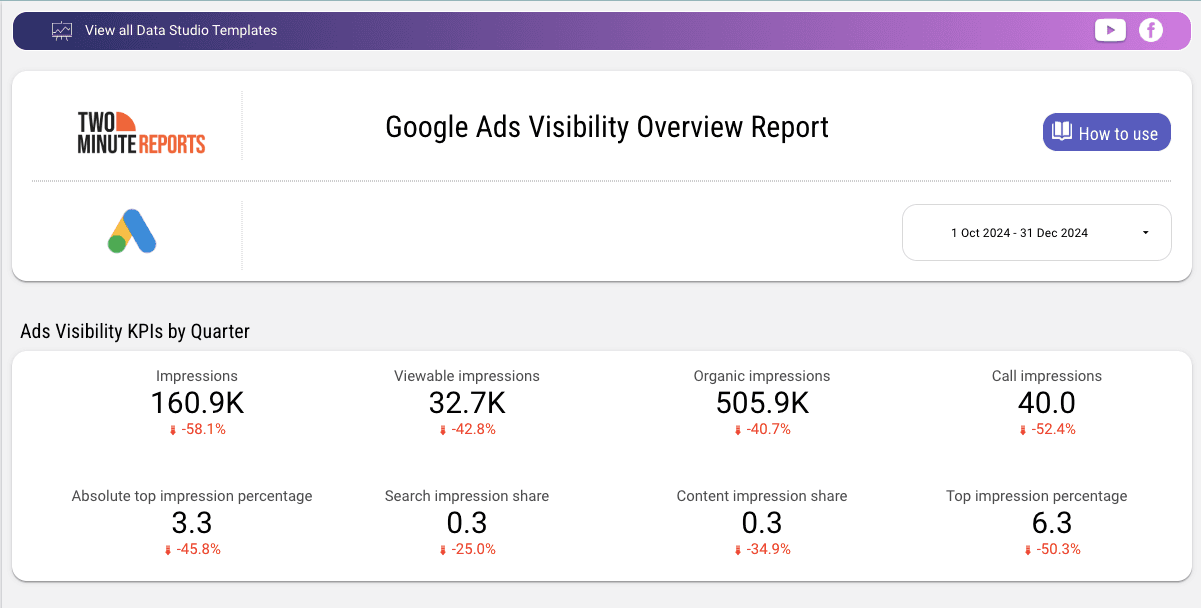
Track Google Ads visibility effortlessly with the Google Ads Visibility Overview Report template. Analyze how your ad visibility impacts your campaign performance by tracking key metrics like impressions, search impression share, content impression share, viewable impressions, etc and performance by date, device, regions and campaigns.
Key takeaways:
- Get a comprehensive view of ad visibility in one template.
- Easily track key performance metrics.
- Compare top impression vs absolute top impression over time.
3. Google Ads monitoring report

Monitor key Google Ads metrics such as amount spent, impressions, CPC, CTR, average time spent on site, etc, in a single, interactive dashboard.
Key takeaways:
- Compare CTR and bounce rates to understand campaign performance.
- Dive into top ads data for actionable insights
- Visualize impressions by platform and country for global performance tracking.
4. Google Ads vs Facebook Ads vs LinkedIn Ads dashboard
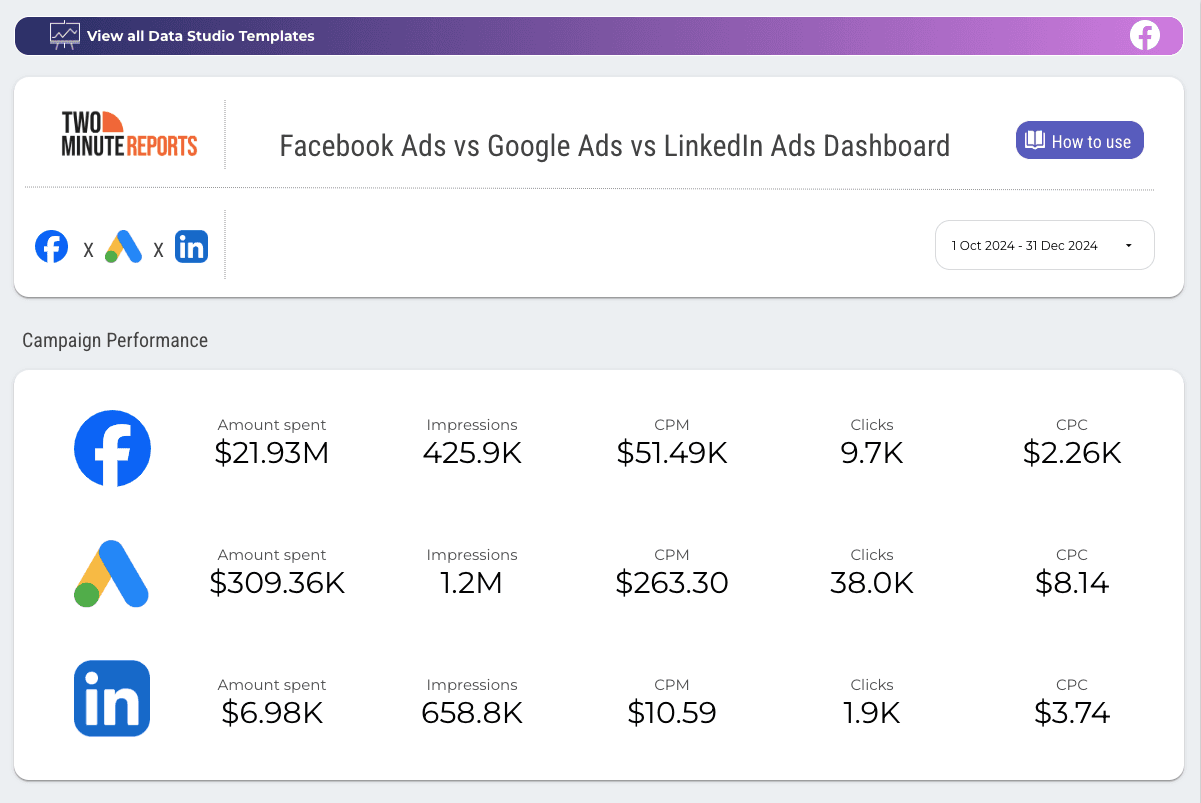
This multi-source ads template consolidates key KPIs from Facebook Ads, Google Ads, and LinkedIn Ads into one easy-to-use template. It provides a collection of scorecards for metrics like amount spent, impressions, CPM, clicks, and CPC across all three platforms.
Key takeaways:
- Track key metrics like cost, impressions, and clicks in dedicated tables.
- Visualize global click distribution with a geo chart for deeper insights.
- Optimize your budget by tracking the amount spent across all three platforms.
Track key Google Ads metrics with zero hassle
Every customer story starts with a search. While Google is ultimately the right way to tap into this buying journey, tracking the key metrics that make up the plot can be daunting.
By focusing on the above important Google ad metrics, you can refine your client’s campaigns, enhance performance, deliver measurable results, and maximize advertising effectiveness to drive better campaign outcomes.
To simplify your workflow, Two Minute Reports provides a comprehensive Google Ads reporting tool that helps you:
- Automatically extract key metrics from client Google Ads accounts
- Customize reports to get a holistic view of the customer journey
- Streamline and automate reporting to save time and increase efficiency
Ready to take your Google Ads reporting to the next level? Sign up for a free 14-day trial and start producing actionable reports effortlessly.
Frequently Asked Questions
Every key metric impacts your Google ad campaign. However, tracking the Google ads conversion rate makes sense as it depicts whether your campaign’s end goal is served.
Google ads KPIs measure the performance of your marketing goals against preset targets. A good analysis of KPIs should enable you to make the right decisions. They are pivotal in moving your business forward.
To measure the success of your Google ad campaigns, track key Google ad metrics like CTR, CPC, CPA, ROAS, etc. However, remember to determine KPIs and metrics based on your campaign goals.
Don’t blindly auto-apply Google’s recommendations. Google Ads’ automated suggestions work best for the platform, but does that align with your ad strategy? The answer to this question brings a colossal shift to your campaign’s goals. So think twice before you auto-apply changes.
Related Blogs

Meet the Author
Shalini MuruganShalini is driven by ideas that create a tangible impact. At Two Minute Reports, she specializes in content that helps marketers optimize their reporting workflows. When she's not transforming complex data into meaningful insights, you might find her lost in a book, jotting down ideas in her notebook, or connecting the dots others overlook.



